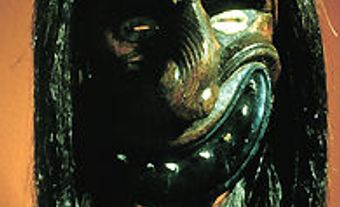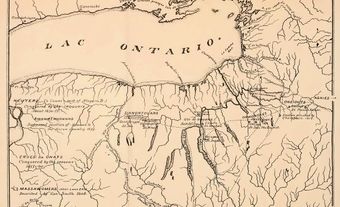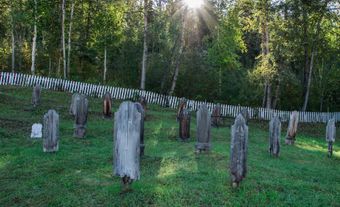Spiritualism
Spiritualism is both a religious philosophy and movement with epistemological ties to older traditions. Some adherents band together into churches while others who hold the same or similar beliefs do not affiliate. By communicating with spirits of the dead, its adherents argue that they can establish the validity of personal survival after physical death. The movement includes a number of phenomena anthropologists find in a range of other societies, including voluntary spirit possession, spirit communication, nonbiomedical healing, divining and prophesy. While there are some similarities with traditional shamanism, mediums do not fulfil the criteria of SHAMANS and should not be confused with them.
History
Modern spiritualism as a religion developed in the 19th century within a larger spiritual and mystic resurgence based on such influences as earlier mysticism, Emanuel Swedenborg's writings and North American native beliefs. Through the work of 18th-century Austrian physician F.A. Mesmer, trance and clairvoyance had become familiar. In the mid-19th century Andrew Jackson Davis and Phineas P. Quimby were especially important to the development of spiritualism and other spiritual movements. THEOSOPHY has been an important substantial influence on the subsequent development of spiritualism.
The origin of the 19th century spiritualist movement is credited to 2 sisters, Margaret and Kate Fox (aka Margaretta and Catherine or Kate) of Hydesville, NY. Their ages are given in various sources from 10 and 7 up to 15 and 12 respectively. They began to communicate with the spirit of a peddler through rapping noises on 31 March 1848. The family had previously lived in the Belleville area, Canada West, but moved into the Hydesville house in December 1847. An older sister, Leah (married 3 times: Fish, Brown, Underhill), who also developed mediumship abilities, lived in Rochester, NY, and Margaret and Kate went to live with her there a short time after the rappings began. Through the publicity given the Fox sisters' spirit rappings, interest in spiritualism spread rapidly and was in Canada by 1850. The oldest sister of Margaret and Kate, Elizabeth Ousterhout, remained in Canada West in Consecon, near Belleville. Kate, her mother, and probably Margaret visited Elizabeth in 1854 and 1855, stimulating more interest in spiritualism around the towns of Consecon and Bloomfield. While there Kate met the Canadian writer Susanna MOODIE, who was deeply impressed with her clairvoyant abilities.
Spiritualists were especially active in Montréal , Toronto, London, Ottawa, St Catharines and Bloomfield. There was a phenomenal spread of spiritualism across the US in the 1850s and it probably reached BC from there at least by 1870. It arrived in Britain in 1852 and spread throughout the continent.
Although initially spiritualists were organized into investigative associations and societies, during WWI they began to establish churches. Today the 2 major Canadian parent associations to which some churches belong are the Spiritualist Church of Canada and the International Spiritualist Alliance. Most, however, remain independents. Walter Meyer zu Erpen has documented 47 churches or groups in 6 provinces of Canada in 1994. BC has 11, Alberta has 3, Manitoba has 2, Ontario 25, Québec 4 and Nova Scotia one.
In Canada most spiritualists have been in Ontario followed by BC, Alberta, Manitoba and Québec, but the number of people claiming to be spiritualist has always been small. The 1901 Canadian census counted 616, which grew to 2263 in 1931, perhaps as a partial response to the high death rates during WWI and the 1918-19 INFLUENZA pandemic. The figures dropped to 1214 in 1941. Spiritualists were not listed as a separate category again until 1981, when there were 1940. Significantly, by the 1991 census there were 3735. In recent years individuals in the Mystical Movement and New Age (see NEW RELIGIOUS MOVEMENTS) are becoming involved with spiritualism, often attending services and, more importantly, development circles. This has contributed to the largest recorded number of spiritualists thus far in Canada. In November 1995 the Gateway Centre Spiritualist Church in Calgary opened a home page on the World Wide Web with information about beliefs and the churches. This kind of innovation may contribute to an even greater resurgence in interest in spiritualism in the future.
A number of prominent people have been spiritualist or have shown a deep interest in spiritualism while retaining their traditional religious affiliations. Two of the best known are Sir Arthur Conan Doyle and Prime Minister Mackenizie KING.
Beliefs
The focus of spiritualism is to provide evidence of survival of the personality after death, and therefore it emphasized contact with spirits of people who are now dead. It is not fortune-telling. The dissemination of the spiritualist system is simple: all that is required to begin a group is a person with "mediumistic" abilities. Early spiritualism emphasized such physical "proofs" of spirit communication as table rappings by spirits, materialization of spirits, levitation and other phenomena presumably from the spirit world. Although these may sometimes apparently occur in modern seances, they are not as important in the current movement. More significant are the communications from the spirit through mental mediumship.
There are 7 principles to which most Canadian spiritualists subscribe, including the fatherhood of God (not a person but the creative universal spirit) and the continuous existence of the human soul. Some, but not all spiritualists believe in reincarnation. Based on these principles are 2 main tenets: the survival of the individual personality, or spirit, after death, and the concern of those in the spirit world for the living and their ability to communicate with the living. The objective of spiritualism is verification of these 2 tenets rather than simple belief that they are true. Verification is accomplished, spiritualists believe, by spirits' communications to the living through mediums.
Communications from the spirit world vary. Some are personal messages to an individual containing information which demonstrates and confirms the survival of a loved one and thus verifies for the individual survival after death. Spiritualists believe that everyone has at least one spirit "guide," who is around to aid, protect and instruct. Guides are spirits of people who have died. They may identify themselves by names they had during life but often come metaphorically as a chemist, a doctor, a joy child, or master teacher and speak in a stereotypic language associated with that type.
Spiritual healing is increasing in importance among spiritualists. It differs from faith healing in that faith healing usually occurs in churches, is performed by clergy, normally requires some faith on the part of the sick person, and frequently claims instantaneous cures. Spiritual healing requires no faith on the part of the patient, and rarely produces instantaneous cures.
A healer believes that spirits work through him or her to send "energy" to the patient. The healer is merely an "instrument" through which the spirit acts.

 Share on Facebook
Share on Facebook Share on X
Share on X Share by Email
Share by Email Share on Google Classroom
Share on Google Classroom


